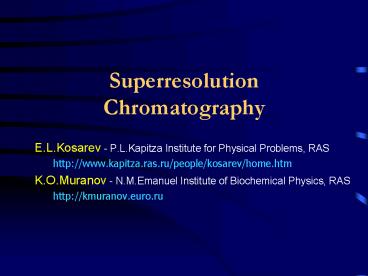Superresolution Chromatography PowerPoint PPT Presentation
1 / 15
Title: Superresolution Chromatography
1
Superresolution Chromatography
- E.L.Kosarev - P.L.Kapitza Institute for Physical
Problems, RAS - http//www.kapitza.ras.ru/people/kosarev/home.htm
- K.O.Muranov - N.M.Emanuel Institute of
Biochemical Physics, RAS - http//kmuranov.euro.ru
2
Chromatographic analysis
- Chromatography
- Adsorption/Partition
- Affinity
- Ion-exchange
- Size-exclusion
3
Peaks overlapping problem
- Peaks overlapped form the joint peak
4
Imperfects of parametric deconvolution
- Supposition - Peak shape can be described
analytically (Gaussian, Lorenz, etc.) - Parametric deconvolution needs
- peak position
- peak wide
- peak amplitude.
- Unknown peak characteristic causes an error.
- For instance, two peaks were identified
instead of three
5
Imperfects of parametric deconvolution Peak
broadening and column voiding
- The main factors
- Diffusion
- Non-specific interaction
- System overdampening
- (irreversible adsorption, filter
contamination, plunger damage, etc.)
6
Problems
- the shape of a real chromatography peak could not
be approximated exactly with any function - the parametric technique cannot give reliable
results
7
We suppose
the problem of overlapping peaks separation
could be accurately solved with the use of a
nonparametric method
8
Nonparametric method
- The peak's shape is determined directly from the
separation of an individual compound and can be
called the point spread function of a
chromatographic column - If the shapes of these peaks are the same
throughout the entire working range of the
device, then chromatogram is a distribution
convolution with the peak of this shape - the point spread function includes all factors
influenced the separation
9
Nonparametric method
- The decomposing a complex spectrum into the same
components is achieved by solving an integral
convolution equation - For this equation
- the input data is the chromatogram
- the convolution operator kernel is the point
spread function of the chromatograph column
10
Analysis of chromatography separation data with
the RECOVERY software package
- Method
- A protein mixture of known composition (bovine
serum albumin monomer, dimer, and trimer) was
separated by gel filtration for obtaining of
heavily overlapping peaks. - The data was processed with the use of the
RECOVERY software package - The result was compared with the finer separation
data obtained with the use of the HPLC.
11
BSA chromatography and point spread function
determination
- A - Elution profile of bovine serum albumin
(BSA). - The blue arrow indicates unresolved peak
- Red dashed lines mark the time interval when the
BSA monomer fraction was collected - B - Elution profile of the collected fraction
- Absence of unresolved peak
- Strongly pronounced a peak asymmetry
12
Recovering of the chromatographic separation data
- A - the source BSA chromatogram
- B - point-spread function
- C - recovering result of the chromatographic
separation data with the RECOVERY software
package.
13
The RECOVERY result vs. HPLC separation
- A - data recovered with nonparametric approach
- B - Elution profile of HPLC separation (TSK G2000
SW Spherogel, 10mm X 600 mm, flowrate -
0.5ml/min) - Both Recovery software package and HPLC found the
BSA monomer, dimer and trimer in protein mixture - Recovery shows the more precision result
14
Peak width and whole column limit- under
investigation
- Separation of the rat eye lens crystallins
(magenta) - 10 kD - 1.5 MD limit
- Peak width of the standard proteins (blue)
15
Conclusion
- the proposed method fundamentally improves the
quality of the chromatographic separation - RECOVERY software package for the gel filtration
data significantly increased the resolution of
this method and exceeded the quality of the
separation obtained with the HPLC technique - new possibilities are achieved through reasonable
processing of the measured data with no
complication in the instrumentation - cost of the used instrument complex for gel
filtration (1,000) is roughly 15-20 times lower
than that for the HPLC setup (20, 000).

